Monday, September 4th
Siem Reap, Cambodia
Did not get a lot of sleep but there really wasn’t a lot of time to get it anyway. It was fairly uncomfortable in the room and, frankly, we were very much looking forward to really starting our tour. The alarm reminded us to start moving at 3:30 and we were downstairs a short while later sitting outside the hotel entrance waiting for the others. Of course there was no time for breakfast but Mel and I did have some snacks then on board the minibus when we left at 4:35 they had some snack bars and water waiting for us.
The whole reason for the early start was so that we could first get our tickets then go to Angkor Wat to see the sunrise. The ticket (available in one day, three days and seven days durations) provides access not only to Angkor Wat to all of the temples and other historic sites in the Angkor region. Angkor Wat is the most famous of the sites but I really was not aware that are so many other temples in the area. Angkor was the capital city of the Khmer Empire so, as such, had a lot of important buildings with the temples being the ones that have, predominantly, survived.
The ticketing complex (it was big) is just south of Angkor Wat on the road out of Siem Reap and was already quite busy when we arrived at about 4:45 with a number of coaches, tuk-tuks, and other vehicles in the car park. Rous showed us to a counter that did not have so many people waiting at where they took our picture for the tickets then suggested we might want to find something to eat though the queue for the only stall selling food was way too long so we wandered around sleepily for a few minutes before returning to the coach. We were given a lanyard with our three-day tickets to hang around our neck.
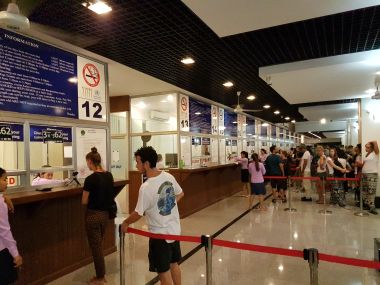

We stopped briefly at a checkpoint on the final stretch of road to Angkor Wat. On the drive Rous explained a bit about the area and Angkor Wat. I was quite surprised to learn that actually it is not that old having been built in the 12th century and that it never really fell out of use just decayed into relative obscurity hidden in the jungle before being restored in modern times. The site is on an island surrounded by a large square moat 1.5 km by 1.3 km, and 190 m wide. Yeah, it is big. We drove around the moat and even in the darkness could make out the perfectly square lines. The driver stopped at the west entrance where we piled out squinting in the blackness to see if we could see anything of the temple across the water.

The main stone causeway leading into the temple across the moat is being restored so we had to walk across a temporary “pontoon” bridge which was quite exciting as it wiggled under the feet of the great hordes of tourists that seemed to have the same idea of seeing the ruins at sunrise. The torches (flashlights) we were told to bring certainly came in handy.

A low wall 1025 m by 802 m surrounds the island complex that we passed through the west gate into the temple itself. Rous guided us to the edge of a small pond to the left of the main stone path where there were already a lot of people waiting. She told us we should meet her back near the path at 6:15 and we scattered to try to find the best spot to see the sun. We could make out the famous pine-cone-shaped spires of the temple against the increasingly bright sky as we headed off to the far left of the pond where there seemed to be fewer people. There were a lot of people selling things - kids with postcards that they shoved into your face as well as locals selling pictures and other souvenirs laid out on blankets.
Mel and I managed to get quite close to the shoreline where we could see the ruins reflected in the calm surface of the pond as the sun slowly rose. The hundreds of tourists all had various photographic equipment. Some had tripods set up in the mud, some just using their phones and others with very fancy cameras indeed. Despite this it was quieter than you might think with only a gentle murmur.
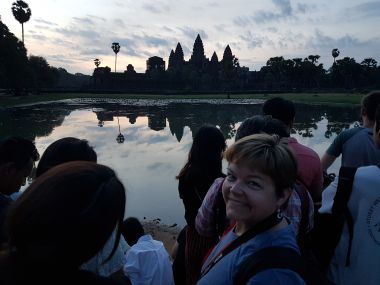
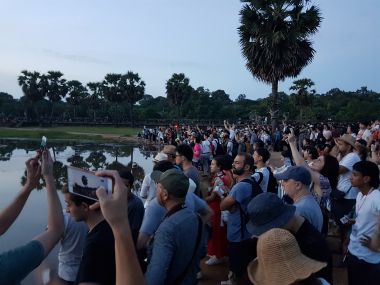
Despite a few clouds it was a beautiful sunrise and we got some very nice pictures, thank you.


We were finally able to see the complex spread out before us and it is quite magnificent. The grey mottled stone really does look like something out of an Indiana Jones movie.
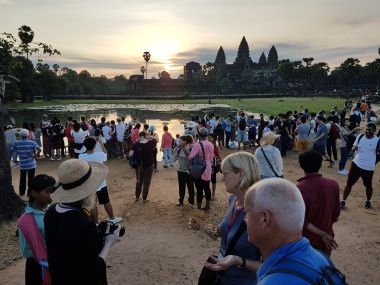
Rous had disappeared after we had first taken up our positions but arrived a short while later with some bread for us to eat that she topped with condensed milk. Wow. Sugar rush.
Our group continued along the rest of the stone path into the temple as Rous told us more about the complex. The wide stone path has massive carved stone railing with expanses of green grass surrounding it then the large trees of the jungle. Walking up to the temple the scale is very impressive yet does not feel overly oppressive. The wall around the central temple is 187 m by 215 m and houses a gallery with some wonderful bas reliefs that we had a closer look at later.
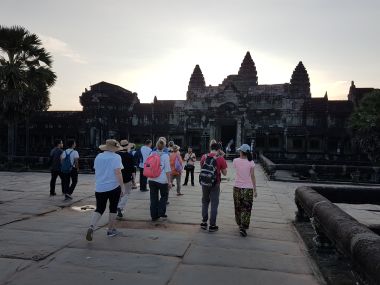
Entering through a gate there are covered stone walkways everywhere and four large open stone pools areas surrounding the central tower. There is very little colour except in the ceilings of the covered walkways. Everywhere else it is mostly shades of grey though regardless the carvings and architecture are absolutely magnificent. It really is like being on a film set.


Rous wanted to get us into a queue to visit the highest section of the temple where she explained would be very busy as the day went on. As it is, we waited 15 minutes sitting in the heat that was already climbing. The third level, the “Bakan”, is the highest section of the temple accessed by some very steep steps where only gods and the king were allowed to visit. There are only a certain number of visitors allowed up at any one time so we waited for our turn. We were given a numbered ticket to hang about our neck for our visit as we climbed the steps upwards.
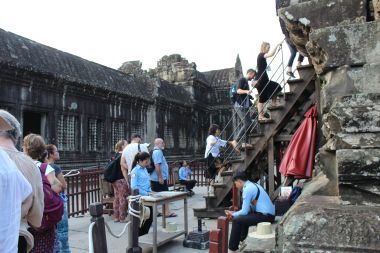

The original steps are far steeper than the ones they have now for visitors but it was still quite a climb. Most definitely worth the climb though with fantastic views of the complex and the jungle surrounding us. It is sort of a miniature version of the ground floor but with much more elaborate carvings. We followed the narrow and somewhat awkward corridor around the outside stopping at every opportunity to have a look out of the windows at the amazing view.


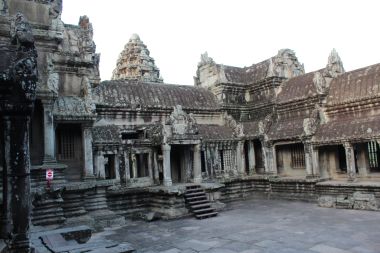
A large balloon in the distance was providing visitors with a different perspective on the site and really the only reminder that we were in a tourist mecca. When we and our cameras were quite exhausted we head back down the steps of doom where we met up with the rest of the group seated off to the side.
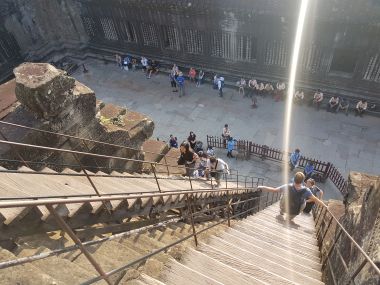

We were next taken to the gallery surrounding the temple where we were shown some amazing bas relief carvings that told a story as you followed them around. An impressive 1,000 square meters of intricate and extraordinary carving that are generally in quite good shape though Rous pointed out the results of several misguided attempts in the past at restoration including concrete and other destruction of the original materials. Thankfully now they are much more sensitive to the preservation of the site that is continually suffering from water and, of course, visitor damage. Amazing depictions of vast armies, gods and fantastic creatures.

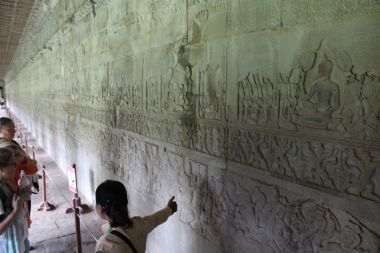
We were given some time to wander around. Rachel was off in search of a sarong which would be cooler in the heat but Mel and I headed back around to the front of the temple to not only see more of the incredible reliefs but also to get some pictures of where we had been earlier. There were a good number of people around but it certainly was not as crowded as it was when we were watching for sunrise. There are also a lot of monks, both young (teenagers) and old around dressed in their vibrant orange sarongs walking in their bare feet. It is really quite a pleasant place and much like a park with no plaques explaining the sites or anything, just the site and the grass surrounding it.

At the front we found some monkeys that were climbing on the building which were quite cute but one did bare its teeth at me as it walked by me a short distance away…



Meeting up again we headed through the east gate, opposite to where we had entered.
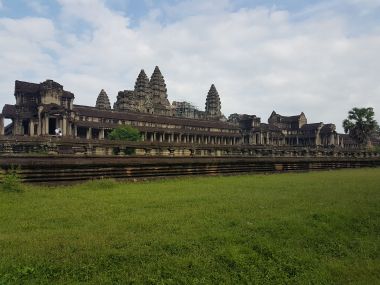
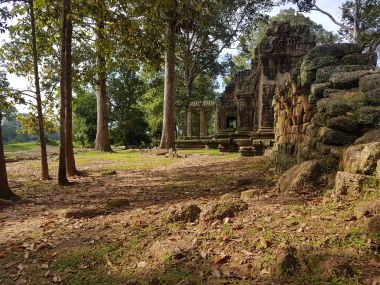
Here there were no tourists as we walked along the path through the jungle then through the ruins of the containing wall before once again crossing the moat this time on a dirt causeway. Surrounding us were the most amazing trees and it was quite peaceful with no one else around.
Still only 8:30 in the morning we returned to the hotel for breakfast. After a quick stop in the room to drop our bag we headed up onto the roof, the sixth floor, where the buffet was set out. Mel and I sat at a table right on the edge of the roof looking out over the town spreading in all directions. It is not the most pretty of places. The buffet was OK but nothing like the hotel in Bangkok. Some fried rice, bread and fruit were enough for us though (the so-called “orange juice” is beyond the pale - I just can’t stand artificial!).


At 10:00 we met in front of the hotel to continue our tour. We very quickly left the busy streets of the city behind as we headed to the north. Paddy fields, the occasional house and village were really all there was to see. Very lush looking with lots of trees and green fields, you can tell it is the rainy season. It must be so much browner other times of the year. The houses are pretty much all up on stilts and well built. Very few people out and about that we could see though there were a number of stalls selling fresh fruit and souvenirs.
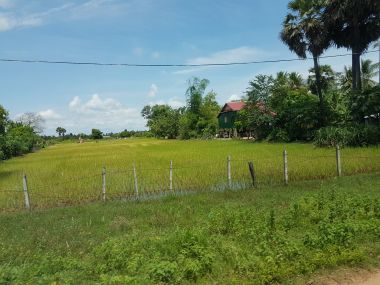

An hour later we arrived at our next temple, Banteay Srei, which was far less busy than Angkor Wat was earlier. The ticket booth and entrance is quite modern with a large tourist market full of stalls beside it. There was a bit of hassle from kids trying to get us to buy things as we entered but generally is was very quiet. I picked up a cold drink while we waited for the rest of the group and Rous to give us an introduction to the site before we walked to it. This is a 10th century temple often called the “citadel of the women”, or “citadel of beauty” because of its intricate bas relief carvings. An information panel talked about the importance of irrigation and how extensive it was when these structures were built.
A long roadway through the trees led to the temple. It was quite a warm walk now as it was approaching the heat of the day. The temple is quite different looking with red sandstone featuring throughout. Tony is an archaeologist so gave us a bit of a lecture on the laterite used on the exterior of the temple - A red porous looking but very hard rock that has been carved into massive bricks. It is red because of the high iron oxide content. Evidently, for our Australian friends, this is quite a common stone there.

The temple complex is at a much more human scale than Angkor Wat with only the single ground level story and a main section in the middle of a small moat. The carvings here are quite different as well with a lot more decorative rather than narrative pieces. The iconic Cambodian “pineapple” towers were still here but on a much smaller scale. A lot more pieces of art everywhere you looked.
It was a very pleasant visit as we started to relax a bit. Rous posed for our cameras framed in a stone window which of course was imitated by others in the group.
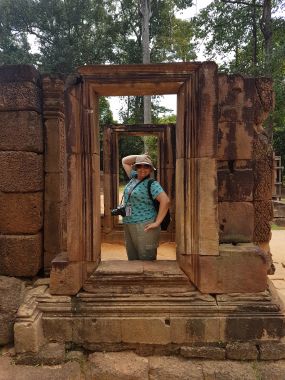
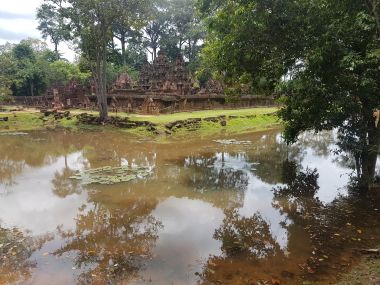
As we left the temple there was a group of men playing traditional instruments rather noisily who were looking for donations having been injured by landmines – “Traditional Music Band’s Victim of Land Mines” (sic). We sat for a few minutes to listen with a few of our group leaving a small donation before heading back to the main entrance.
We did a bit of shopping in the market. I even picked up a rather nice white cotton shirt after a bit of haggling ($15 down to $10 then down to $9) while Steph got quite involved, eventually having to be tracked down before we could head out once again.
We stopped beside the road for a few minutes to have a look at some local people making cane sugar in large aluminum containers. Rous got us some samples to try. It is quite a brown coloured mixture it is quite tasty and I ended up buying a small container of it to take home ($1).
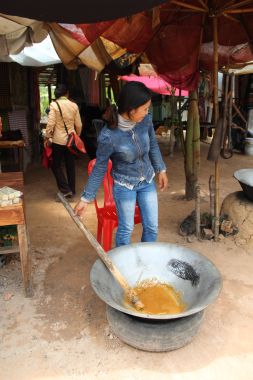
Mel and I continued our shopping picking up some rather nice looking chopsticks and a small covered bowl ($8 for both) made of this amazing black-brown wood. Of course, our friends from OZ would not be allowed back into the country with it due to their strict quarantine laws but we would have much less of a problem. Mel also found a nice scarf ($4). We really splashed out and I even had to borrow $1 from Carl!

About thirty minutes later we arrived at the next site which was just off of the road: “Prae Roup” (Pre Rup) temple. This is a much smaller, simpler and older temple (10th century) though with several rude large towers (“prasat”) in the middle. I immediately headed up a tall set of stairs in the middle for the view of the surrounding area which was a bit tough in the heat (it was 1:30 already). Again we saw some laterite in the walls but the temple towers were built of much smaller bricks. It was nice to just sit and take it all in. Very few tourists here though there was a small group of stalls at the edge of the car park opposite.
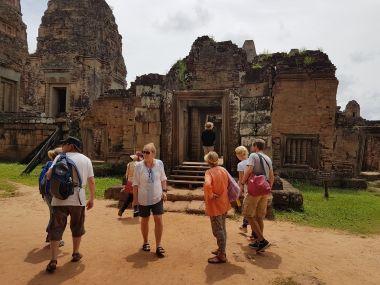
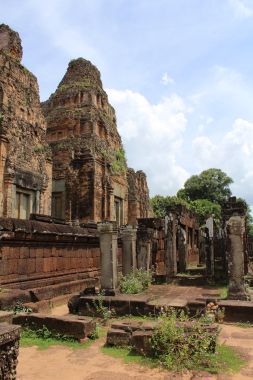
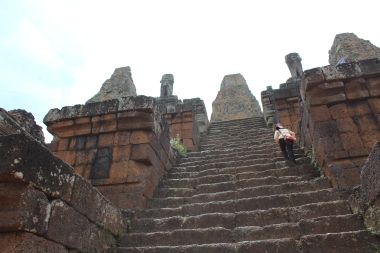

It had been quite some time since breakfast so we stopped for lunch at a small touristy place beside an irrigation lake (Srah Srang) the Khmer Angkor Kitchen nestled in amongst the trees. Upstairs was air conditioned so we sat down and relaxed. It had been a lot of walking in the heat so we were all needing a bit of relaxation. Mel and I shared a portion of “Khmer Curry” (pork; $7.75) that included rice which was very nice and quite a generous portion size too. Yeah, just a coke on the side as they did not have any really interesting things to drink ($1.75).

Mel also tried the local “Angkor” beer (large bottle $4) which she, surprisingly, enjoyed. She does not normally like beer.
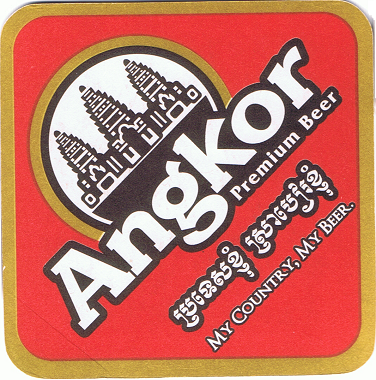
As we returned to the coach Marilyn could not resist petting the dogs despite being warned by Rous (and the written travel guide we have been given) that this was not advisable due to rabies, fleas, mange, and what have you that they may have. Rous had another word with her about it. Hopefully she will be a bit more careful. I don’t think any of our group want to catch something from her having handled the animals. There were some interesting looking cows which warranted a few pictures as well, evidently…
At about 3 we headed out again. Rous has been using a microphone in the bus to talk to us throughout our tour which has been very good. She hasn't been overwhelming us with detail and including a lot about contemporary life which we have found very interesting.
Beside the road we could see ruins here there and everywhere. Loretta and I had the driver stop to take some pictures of the tiny Chau Say Tevoda Temple and Thommanon temples located on opposite sides of the road from one another. Just stop beside the road and you can see 11th and 12th century (respectively) Hindu temples…They just look like film sets.
We were headed to the truly massive 3km by 3km “Angkor Thom” the 13th century Khmer capital city with the “Bayon Temple” in the exact centre. Before entering the ruins of the city we stopped just before passing under the “Victory Gate”. A bridge over the moat has two a long, carved, seven headed naga serpent carried by rows of figures on either side about 100 m or so long. Rous told us that the French have attempted unsuccessfully to repair some of these statues using concrete but it is still an incredible sight. Most the figures have lost their heads but you can really see what they must have been like when they were first carved.
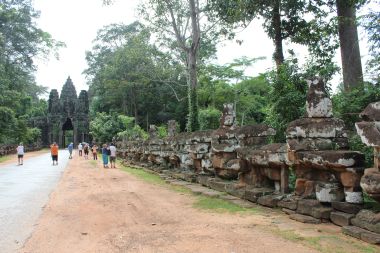
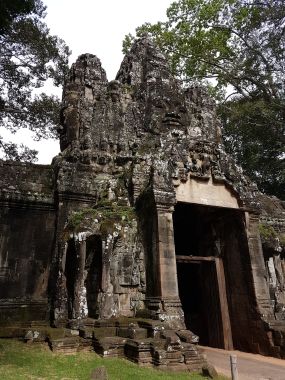
Despite the heat and sun we walked up to the gate itself. 25 m in height the top has a face figure with the now familiar cone structure on top and two smaller cones on either side. The road still goes under this fantastic monument though it is quite narrow with the tunnel through lined with wooden beams. Getting on board the bus again we had the driver stop on the other side to take yet more pictures. Here the walls of the ancient city extend in either directions through the trees many with winding exposed roots.
Driving into Angkor Thom the road stops to turn either left or right at a large balustrade - The “Elephant Terrace” so-called because of the numerous elements carved along its length. Turning left we immediately came upon the “Bayon Temple” - A fairly small temple (as it goes) in the middle of a square moat around which the road travels. We stopped briefly in a car park for people to get refreshments and look around. A few people were having their wedding photos taken with the magnificent backdrop. There was also a shine with a buddha figure clothed in gold. We were more interested in pictures of Bayon.
Back in the bus we were taken around to the eastern entrance of the temple where as we were leaving the bus a few people expressed an interest in visiting the toilets so three of us that were not so keen got out to have a look at the temple while the bus left in search of a toilet. The entrance is over a path of large carved stones with the temple consisting of many cone-shaped towers with large faces carved into them. The faces are amazingly lifelike and all very different from one another. All around the exterior of the temple are yet more elaborately carved murals showing various battles. I was able to climb all around the ruins though particularly delicate areas like the murals were, of course, hands-off. A short time later the toilet group returned and Rous gave us a bit of a tour of the temple, explaining about some of the carvings. Mel and I climbed to a higher level in the temple to have a look around. There were not many tourists here so it was quite good to take in the ambiance and wonder of it all for a few minutes. Everywhere the carved smiling faces look down on you. It looks at times like the whole place is just about to crash back down into the jungle - poised on the edge of complete destruction.



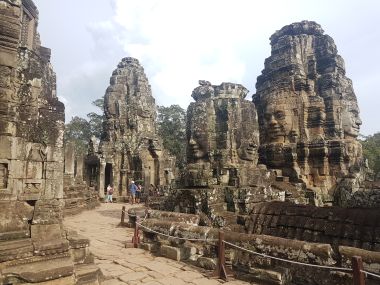

Timing is a bit tricky for us right now not knowing how long it will take to see anything so we were early back at the east gate waiting for the rest of the group before continuing on. I was not that keen to leave and sat to admire the temple for a few minutes before eventually dragging myself back to the waiting air conditioned coach. As we returned back the way we had come the side of the road had a display showing how they believe the temples were constructed with the great stone slabs pulled into place by elephants. We insisted the driver again stop so we could take pictures of the Elephant Terrace. It is very long and quite low with these simple elephant shapes carved into it - Their bodies serving as the wall. I obliged a Chinese tourist in taking a picture of her and her child with the terrace behind. A short distance behind the terrace somewhere in the jungle is the “Baphuon Temple” but we were not visiting that today.
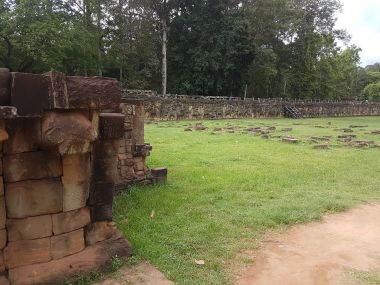
At the south gate of Angkor Thom we stopped again to see the nagas on either side of the road again but these are in much better condition having been more sensitively restored by the Germans. These ones actually have heads! The moat on this side of the city, the main entrance on the road from Siem Reap, is much wider than on the east gate and it is much busier. We could see some people offering elephant rides to tourists which we had been cautioned against before coming here as the elephants are often mistreated.
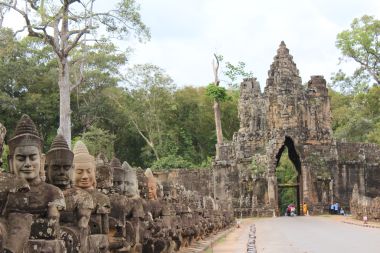
Back in the coach we passed by a number of monkeys beside the road then later a number of hammocks that you can rent set out beside the moat of Angkor Wat. Indeed, the area is very much a parkland and we saw many people picnicking and enjoying the beautiful surroundings.
Back in the city busy with bikes, motorcycles, pedestrians, buses, cars, carts, and tuk-tuks we returned to the hotel at about 6 pm. Rous had given us some recommendations for dinner so Mel and I returned to our room for a few minutes then walked along the side of the canal to the market, passing by the Hard Rock Café before crossing the river. They are not so big on pavements (sidewalks) here so often we have to take our chances on the road. We passed by “Psar Chas” (the old market), taking a quick look in at the bustling food area which I found far more interesting than the cheap clothing and souvenirs for sale. It is definitely not fancy with plastic bowls full of all manner of seafood and fish.

Back on the street we had a look at a few of the choices for dinner we had been given by Rous settling eventually for “Khmer Kitchen” (http://www.khmerkitchens.com/) on a corner right opposite the market. We were given a table inside the restaurant right on the corner of the two streets so we spent some time watching the traffic. Of course, the ground floor was entirely open to the outside so the noise of the street just added to the ambiance. We found amusing some of the names of the tuk-tuks parked outside: “Rolls-Royce”, “Batman Tuk Tuk”, etc.
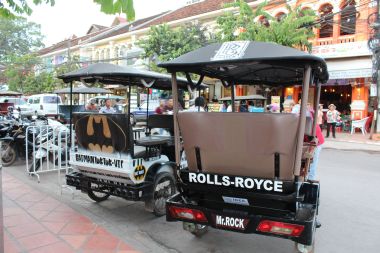
There are street vendors all around selling snacks including various fried foods, ice cream, shakes, fruit, etc.
On the pavement they were cooking on a barbecue for the restaurant from which we had barbecue chicken wings (very big wings, very delicious, served with fresh vegetables and a nice dipping sauce). Mel continued her drinking of local beers this time ordering a “Cambodia” beer which confusingly was served in a “Anchor” glass ($2.50). She seems to really enjoy the local beers and, obviously, in this heat it is very refreshing.
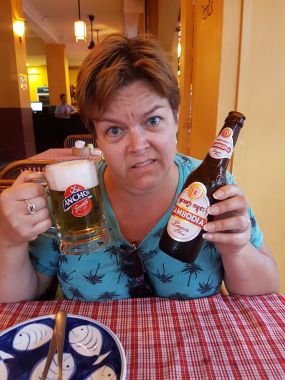
For our dinner we had a beef dish with bean shoots ($5) and a noodle soup ($4.50) alongside our chicken wings ($4.50). Of course served with rice. Not fancy but very, very tasty. I also had two glasses of wonderful passion fruit juice ($1.50 each). At $19.50 for the two of us, a very good deal indeed.
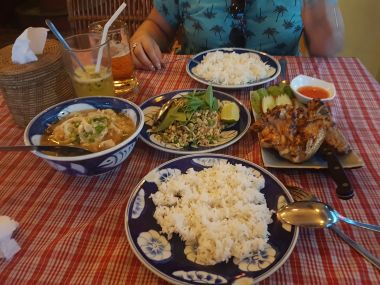
By the time we finished eating it was dark and we fancied a bit of ice cream but the one place we found walking along the pavement/road was quite nice looking but much of the ice cream looked like it was in poor condition - partly melted and not looking very appetising.
One of the attractions in Siem Reap for tourists is “Pub Street” (easy to spot with a large neon sign over the road) which is, as you might expect, crammed with cheap drinking establishments with many offering $0.50 draft beer. We saw Sally and Tony who we stopped briefly to chat with before continuing our wandering. Lots of women (and men looking like ladies, of course) hanging around in places looking for company for the evening (if you get my drift). There were the typical tourist stalls on the road selling their fried scorpions and spiders just adding to the picture. At times the experience was a bit scary and unsettling. To Mel and myself it is all not really that appealing as we do not drink nor are interested in the entertainment on offer.

We were looking for somewhere to get some ice cream so popped into a couple of grocery stores but were not that impressed so sadly headed back towards the river to make our way home. We passed by one final grocery store that we decided to check out and, bingo, Mel found an ice lolly ($0.90) that she was happy with so sucked on that as we made our way along the canal. This walking on the road is a bit scary particularly on the narrow bridges that serve both pedestrians and cars…

At the hotel we talked briefly with some of our group on the small patio out front intrigued to find lizards hanging from the ceiling above our head (our Australian friends are not that bothered as they are used to them). Back in the room I had a shower and did a bit of clothes washing, causing a minor lake in the bathroom before settling down for bed. It has been a very long, incredible day. At least tomorrow we are able to sleep in a bit (7 am departure! The day is half gone by then!).